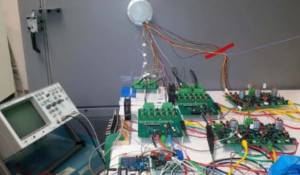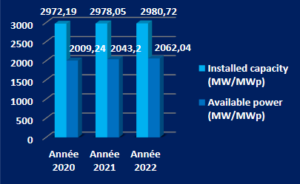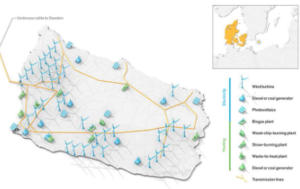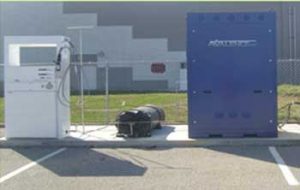Research Interests:
Click For | Updated CV Dated February, 2024 |
Dr. Sandrine Mubenga, PE
Power systems, battery energy storage, renewable energy systems, electric vehicles, and
energy efficiency. We conduct our research in the Power Electronics Laboratory which is
housed in North Engineering Building Room 2012.
A Case Study on the Hybridization of an Electric Vehicle and the Development of a Solar Powered Hydrogen Generating Station |
Abstract: Because they do not emit carbon dioxide, electric vehicles (EV) have emerged as a non-emission alternative to internal combustion engines. However, their limited driving range and the long time required to charge the battery bank remains a drawback. One solution to improve the driving range of an EV is to integrate a fuel cell (FC) with the battery. Like EVs, fuel cell hybrid vehicles (FCHVs) produce no pollutants during operation. However, production of the hydrogen for the fuel cells and the charging current for the batteries requires large amounts of electric energy. Since the vast majority of the energy produced by electric utilities in the US comes from fossil fuels (mostly coal), traditional production of the electricity to fuel FCHVs will still result in high levels of pollution. This pollution could be avoided entirely if the energy to fuel the FCHV was produced from renewable energy sources such as wind or solar. The purpose of this paper is to demonstrate the technical feasibility of FCHV transportation using hydrogen that is produced primarily by solar energy. The first task on this part of the overall project was to implement a fuel cell (FC) on a Kronosport electric vehicle to convert it to a FCHV. The second part of this paper demonstrates the generation of hydrogen using solar energy from a photovoltaic array. The electrolyzer will supply hydrogen that will be transferred to a storage tank on the FCHV via a dispenser (fueling station).
A Bilevel Equalizer for Large Lithium Ion Batteries |
Zachary.Linkous@utoledo.edu (Z.L.); Thomas.Stuart@utoledo.edu (T.S.)
Correspondence: Ngalula.Mubenga@rockets.utoledo.edu; Tel.: +1-419-530-8289
Received: 5 September 2017; Accepted: 21 November 2017; Published: 7 December 2017
Abstract: Due to variations among the cells, large lithium ion batteries (LIB) such as those in battery energy storage stations (BESS) and electric vehicles (EVs) must have an equalizer (EQU) circuit to balance the cell voltages. In spite of their significant losses and other limitations, passive equalizers (PEQ) are used in most applications because they are relatively simple and low cost. Active equalizers (AEQ) reduce these PEQ problems, but are not as widely used due to their much higher cost and complexity. A new hybrid circuit called the Bilevel EQU (BEQ) combines the PEQ and AEQ to provide much higher performance than a pure PEQ but at a much lower cost than a pure AEQ.
Keywords: lithium ion; equalizer; passive; active; bilevel; discharge capacity; battery management

A Low Cost Hybrid Equalizer for Lithium Ion BESS |
Ngalula Sandrine Mubenga, Assistant Professor of Engineering Technology, University of Toledo, ngalula.mubenga@utoledo.edu
Thomas Stuart, Professor Emeritus of Electrical Engineering, University of Toledo, thomas.stuart@utoledo.edu
Abstract— Several Battery Energy Storage Systems (BESS) have been installed by electric utilities, and reports indicate their development is going to accelerate. The vast majority of these now
use lithium ion batteries (LIB which require electronic equalizer circuits (EQU) to balance the cell voltages. Several types of EQUs have been proposed, but all present versions have either cost or
performance issues. However, a new type of hybrid EQU called the Bilevel Equalizer (BEQ) has been proposed to provide a balance between cost and performance. This study provides additional insight into the analysis and design of these systems.
Index Terms—Lithium ion, equalizer, bilevel, passive, active

A BiLevel Equalizer For Lithium Ion Batteries |
Ngalula Sandrine Mubenga, Member, IEEE, and Thomas A. Stuart, Senior Member, IEEE
Abstract— Electric powered aerospace vehicles such as drones (UAVs) are now in widespread use, and recent reports indicate their development is going to accelerate. Virtually all of these types
of UAVs now use lithium ion batteries (LIB), but LIBs require electronic equalizer circuits (EQU) to balance the cell voltages. Several types of EQUs have been proposed, but all present versions have cost and/or performance problems. However, a new type of hybrid EQU called the Bilevel Equalizer (BEQ) has been proposed that avoids these problems. \
Index Terms—Lithium ion, equalizer, bilevel, battery management, passive, active, discharge capacity

The Efficiency Measuring Apparatus for the Design of Li-Ion Batteries Equalizers
Ngalula Sandrine Mubenga, PhD, PE, SMIEEE, Engineering Technology, The University of Toledo, Toledo, USA, Ngalula.mubenga@utoledo.edu
Abstract— Lithium ion batteries require an active equalizer (AEQ) or a Bilevel equalizer (BEQ) to transfer charges between the series connected cells or sections of cells. This research developed a suite of tools that are adequate for the design of BEQ and inductor based AEQs. The AEQ Inductor tool, the Efficiency Measuring Apparatus, and the EQU Design App were tested and validated against physical experimentation. The accuracy of these design tool proved to be higher than 98% compared to experimental results.
Keywords—Efficiency, equalizer, lithium ion batteries, battery management system, design tool, inductor design, battery performance simulation, BMS, BESS, energy storage, cell balancing

Overview of the Electricity Sector and Impact of the Electricity Regulatory Authority (ARE) in the Democratic Republic of the Congo from 2020 to 2022
Ngalula S. Mubenga, Electricity Regulatory Authority, Kinshasa, DRC, ORCID: 0000-0002-1258-9794, contact@are.gouv.cd; Janvier Kamundala*, Eastern Pool, Electricity Regulatory Authority, Goma, DRC; j.kamundala@are.gouv.cd; Christian Bakole Directorate of Econ. Affairs & Tarrifs, Electricity Regulatory Authority, Kinshasa, DRC; c.bakole@are.gouv.cd; Patrick Tshabola, Technical & Regulatory Directorate, Electricity Regulatory Authority, Kinshasa, DRC; p.tshabola@are.gouv.cd; Daddy Mbombo, Technical & Regulatory Directorate, Electricity Regulatory Authority, Kinshasa, DRC; d.mbombo@are.gouv.cd; Marco Kuyu, Directorate General Electricity Regulatory Authority, Kinshasa, DRC, dga@are.gouv.cd
Abstract— Historically, the national electric utility company (SNEL) had a monopoly in the electricity sector which prevented private companies from participating in the sector in the Democratic Republic of the Congo (DRC). Since 2014, the country applied reforms that allowed penetration of private companies. For effective liberalization, the Congolese government created the Electricity Regulatory Authority (ARE). This paper is a study based on the ARE’s 2022 annual report, and best international practices adopted by the ARE. It presents general statistics of the DRC’s electricity sector from 2020-2022. Data analysis has shown that the annual electricity production increased from 10 TWh in 2020 to 16 TWh in 2022, a 22.6% growth mostly supplied by renewable energy at
97.46%. Furthermore, 91% of the 3282 MW projected capacity will come from hydroelectricity and solar photovoltaic energy. In 2022 alone, thanks to renewable energy, DRC avoided the
emission of more than 10 Mt of CO2.
Keywords— Africa, Electricity Access, Electricity Regulation, Democratic Republic of the Congo, Renewable
Energy,

Grid Connected Solar Photovoltaic in Island States: Challenges, Opportunities and Waste Management |
Ngalula Sandrine Mubenga, PE,MSEE (Author), IEEE Member, IEEE PES Member, IEEE WIE Member, Sustainability Energy Efficiency and Design Initiative
University of Toledo, Toledo, Ohio- USA, nmubenga@ieee.org
Abstract—Small island developing states (SIDS) strive to continue economic growth, mitigate climate change and reduce their dependence on imported fossil fuels. They offer a geographical landscape which encourages distributed generation in order to provide power to end users that are located in remote areas. Often times, this distributed generation is accomplished through grid connected solar photovoltaic (PV) systems. Because they do not emit greenhouse gas, and they use the free light from the sun to generate electricity, solar PV systems provide renewable energy in a sustainable way. This paper will respectively discuss the challenges and opportunities associated with grid connected solar PV in island states. It will also propose potential waste management strategies of such solar PV systems from cradle to grave.
Keywords- SIDS; solar PV; islands; challenges; opportunities; waste management; climate change, renewable energy; sustainability; photovoltaic; energy; distributed generation, STEM, green economy, workforce, tariff, GDP, insolation

Our research has been sponsored by grants from the Ohio Department of Development, iCorps@Ohio, the Rocket Fuel Fund, and TVSF.


